Vegetables are a staple part of the guinea pig’s diet. Apart from hay, guinea pigs need one cup of fresh vegetables daily to keep up with their nutritional needs.
Most experts recommend adding at least 4-5 different vegetables in your guinea pig’s diet, which includes at least two leafy greens. But what are the best leafy greens for our guinea pigs?
Here is a list of safe leafy greens that you can feed to your guinea pigs:
- Lettuce(excluding iceberg)
- Kale
- Cabbage
- Chards
- Spinach
- Collards
- Parsley
- Arugula
- Coriander
- Pak choi(Bok Choy)
- Watercress
So, now that you know what are the leafy greens you can feed to your guinea pigs, you must be wondering How much can I feed in one serving? What are the benefit and hazards of feeding leafy green to our guinea pigs? And much more.
Don’t worry. I have got you completely covered. Let us first begin by having a quick look at some of the benefits of feeding leafy green to our guinea pigs, and later we shall learn what part of those vegetables can our guinea pigs eat and in what quantity.
Are leafy greens good for guinea pigs?
Leafy vegetables can provide a lot of benefits to guinea pigs, and thus, it must be added into your guinea pig’s diet.
Some of the major benefits of leafy green for our guinea pigs are as follows:
Source Of Vitamins:
Leafy greens are usually rich in Vitamins including Vitamin C, Vitamin A & Vitamin K.
These nutrients are essential for the proper functioning of the body.
Some of the significant functions of these nutrients include the Fortification of the immune system, Improving Eyesight, and other essential functions & quick recovery of wounds and diseases.
Contains No Sugar Or Fat:
Leafy greens usually contain the least calories(including sugar) and are low in fat as well.
Thus, adding leafy greens to your guinea pig’s diet is a wise decision to make.
Contains Lots Of Anti-oxidants:
Most leafy vegetables are rich in natural antioxidants like phenolics, flavonoid & more that is needed by the body for fighting against diseases and maintaining a robust immune system.
These antioxidants can help prevent various diseases in guinea pigs, including urinary tract infections and even cancer in some cases.
Are leafy greens bad for guinea pigs?
No, leafy greens are not bad for our guinea pigs. They are definitely a good choice for them.
However, excessive feeding of leafy green vegetables can initiate a few health problems in guinea pigs.
Some of the most common health diseases caused by overfeeding leafy greens are:
Diarrhea:
Diarrhea is one of the most commonly diagnosed health issues in guinea pigs.
It is mostly caused by overfeeding certain kinds of food to your guinea pigs.
Do make sure you introduce a new vegetable slowly and only serve the suggested quantity to avoid such health issues.
Bloating:
Bloating is another common health issues diagnosed in guinea pigs.
It is mostly caused by overfeeding some vegetables like cabbage, kale, etc.
Bladder Stone:
Bladder stones are mostly caused by feeding a high calcium diet to your guinea pigs.
Certain leafy greens like kale, spinach, etc. are rich in calcium, and thus, feeding such greens daily can be a terrible idea for your guinea pigs.
Although most of these health problems can be avoided by feeding the right quantity and creating a balanced diet for your guinea pigs.
What leafy greens can guinea pigs eat?
So, now that you know what the benefits and hazards of serving leafy greens to your guinea pigs are.
Let us have a closer look at each of these leafy greens and learn more about them.
We shall discuss some common varieties of these vegetables that our guinea pigs can eat, what should be the serving size, and more about the same.
Lettuce: Best Leafy Greens For Your Guinea Pigs
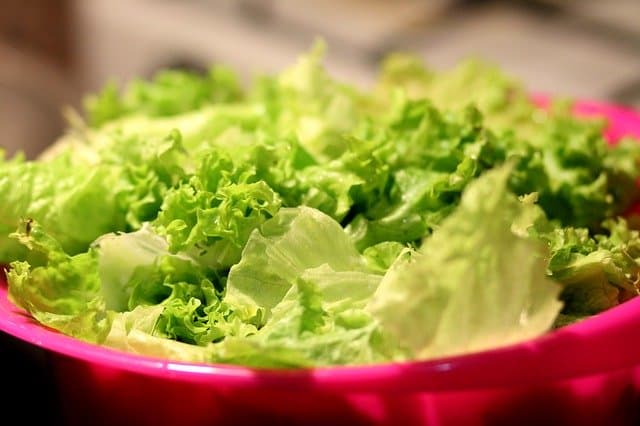
Lettuce is one of the staple food in our guinea pig’s diet. It is rich in Vitamin A, Vitamin C, and other vital nutrients that make them an excellent choice for our guinea pig’s daily diet.
It also contains essential nutrients like Magnesium, Iron & Zinc that is important for our guinea pigs.
Magnesium also helps the body in the absorption of calcium, thus preventing stones, which is a significant health problem in guinea pigs.
There is a wide variety of lettuce available throughout the world. Most of the array can be served to our guinea pigs except iceberg lettuce, as it possesses no nutritional value in them.
Some of the most common variety that you can feed regularly includes:
- Romaine Lettuce
- radicchio Lettuce
- Little Gem lettuce
These lettuce contains the best balance of nutrients and is good for our guinea pig’s health.
Some other varieties of lettuce that you can feed to your guinea pigs include:
- Green leaf lettuce
- Red leaf lettuce
- Endives lettuce
Suggested Feeding: The standard serving size of lettuce shall be one to two medium-size leaf or so depending upon the age of your guinea pigs. You can serve guinea pigs with lettuce every day, but not all varieties of lettuce can be fed daily.
You can learn more about what lettuce can guinea pigs eat daily, What parts of lettuce is safe for them.
Kale

Kale is another excellent leafy vegetable that you must add to your guinea pig’s diet.
Kale is rich in Vitamin C, Vitamin A, and Anti-oxidants, which is a must for guinea pigs.
However, it also contains a decent amount of calcium and potassium that can lead to stone formation and excessive thirst in guinea pigs. Thus, moderate serving is advised.
There are a lot of benefits of feeding kale to our guinea pigs. Some of the most common benefits include:
- Robust immune system
- Prevention of scurvy
- Recovery of wounds
- Improves Digestion
You should make sure you mix it with other low calcium veggies like Lettuce, Bell peppers, Cilantro, Carrots, etc. to make a complete balanced diet for your guinea pigs.
Suggested Feeding: We should only feed one or two small leaves of Kale to our guinea pigs. You can serve Kale 2-3 times a week to your guinea pigs. Feeding it on alternate days can help prevent its adverse effects and provide a lot of benefits to your guinea pigs.
You can learn more about what parts of kale can guinea pigs eat, how to prepare kale for guinea pigs and what other vegetables you can serve alongside from our in-depth article on the same.
Cabbage
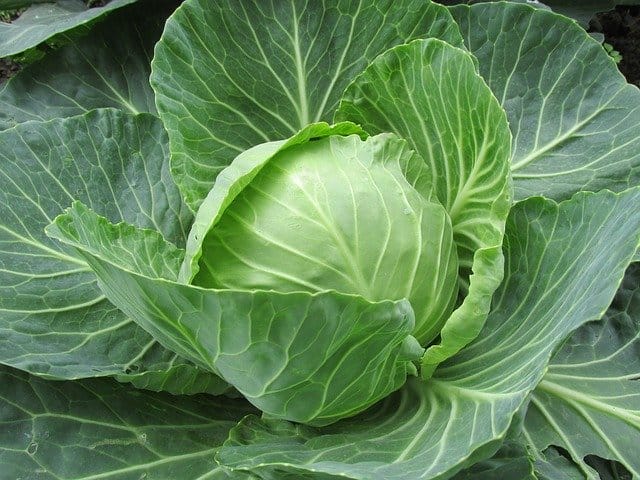
Cabbage is another excellent leafy green that can be fed occasionally to our guinea pigs.
Many people believe that cabbage is terrible for our guinea pig, but the truth is far from the belief.
Cabbage is an excellent addition to our guinea pig’s diet. Cabbage is an excellent source of Vitamin C & Vitamin K, which is a must for them.
However, it can lead to bloating in guinea pigs if fed in excess. Thus moderate serving is advised.
Cabbage is also rich in calcium, hence overfeeding can lead to some sludge in the urine. So, you must feed cabbage only in the suggested quantity.
Some of the common benefits of serving cabbage to our guinea pigs include:
- Prevention of scurvy
- Lowering blood pressure
- Controlling cholesterol level &
- Prevents inflammations
Guinea pigs can eat a wide variety of cabbage; however, you must avoid Chinese cabbage entirely as it is high in calcium. Some of the common varieties of cabbage you can feed to your guinea pigs include:
- Red Cabbage
- Green Cabbage
- Savoy Cabbage
- Sweetheart Cabbage
- Napa Cabbage
Suggested Feeding: It is recommended to serve only one-two small leaves of cabbage to your guinea pigs. Guinea pigs can eat cabbage in up to 2-3 times a week; however, make sure you serve it only on alternate days. Avoid overfeeding as that causes various health issues.
You can learn more about what types of cabbage can guinea pigs eat, What parts of the cabbage are safe for them and more about it from our in-depth article on the same.
Chard
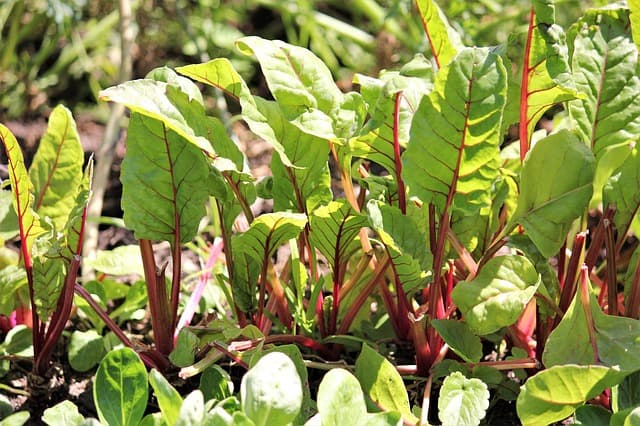
Chards is one such vegetable that can be well defined as a powerhouse of nutrients. It contains a wide range of nutrients right from Vitamins, Minerals to Antioxidants.
Adding chards to your guinea pig’s diet could be an excellent idea, but we must serve it in moderation as overfeeding can lead to Bloating and Diarrhea in some guinea pigs.
There is a wide variety of chard available in the market, and you can feed most variety to your guinea pigs. Some of the most common variations include:
- Red chard
- Green chard
- Swiss chard
- Rainbow chard
Green vegetables including chards provide a lot of benefits to our guinea pigs. Some of the most common benefits of feeding chards are:
- Prevention of diseases including Scurvy.
- A smooth and healthy coat
- Quick recovery of wounds
- Improving eyesight
You should make sure you mix chards with other vegetables to create a well-balanced and complete diet for your guinea pigs. Some of the most common vegetables you can include are: Tomatoes, Bell peppers, Carrots, Cucumber, Zucchini, Green beans, Cauliflower, etc.
Suggested Feeding: It would be best if you fed a small leaf of chard to your guinea pigs two-three times a week. Never feed it daily as it can lead to health issues in your piggies.
To learn more about feeding chards to your guinea pigs you can refer our in-depth article on the same.
Spinach
Spinach is another excellent leafy green you can add to your guinea pig’s diet.
Spinach is an excellent source of Vitamin A and Vitamin C, followed by other vital nutrients like Iron, Potassium, and phosphorous.
Thus it makes for an excellent addition to our guinea pig’s diet.
However, We should serve spinach sparsely to our guinea pigs as it contains a high amount of calcium and oxalate in it that can lead to some health issues in guinea pigs.
Some of the common benefits of including spinach into our guinea pigs diet are as follows:
- An excellent source of Vitamin C
- Contributes towards healthy muscle
- Strong immunity
- It helps fight back diseases.
Being rich in calcium spinach must be mixed with other low calcium vegetables to create a balanced diet for your guinea pigs.
Suggested Feeding: A small leaf or a leaf of baby spinach is just the right quantity of spinach for our guinea pigs. You can serve spinach one to two times a week. Make sure you space out the serving throughout the week instead of serving it on consecutive days.
To learn more about how to prepare spinach for your guinea pigs and what parts of spinach can our guinea pigs eat, read our in-depth guide on the same.
Arugula
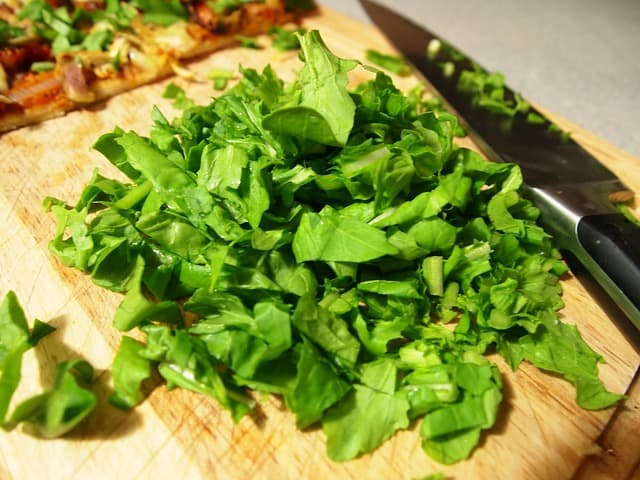
Arugula is a peppery flavor salad known for its wide range of nutrients.
It is rich in a wide range of nutrients, including Vitamin A and Vitamin C, Vitamin K, Iron, Potassium, Zinc, and more.
It also contains a lot of antioxidants that are essential for our guinea pigs. You can definitely throw in some arugula into your guinea pig’s diet.
However, it contains a lot of calcium that can form bladder stones in guinea pigs. Thus, it should be fed sparsely.
Some benefits of feeding arugula to your guinea pigs are:
- Helps in quicker recovery of wounds and clotting of blood
- Improves vision and other vital functions of the body
- Helps in the formation of red blood cells
- Helps fight back diseases
Although arugula possesses some benefits for our guinea pigs, we still cannot include it in their daily diet.
The high proportion of calcium in arugula can lead to the formation of bladder stones and sludge that can be harmful to our guinea pigs.
Suggested Feeding: It is recommended to feed only a small leaf of arugula to your guinea pig at a time. Also, it is best to limit the serving to 1-2 times a week to ensure that your guinea pigs don’t get too much calcium in their diet.
You can learn more about feeding arugula to your guinea pigs from our in-depth guide on the same.
Parsley
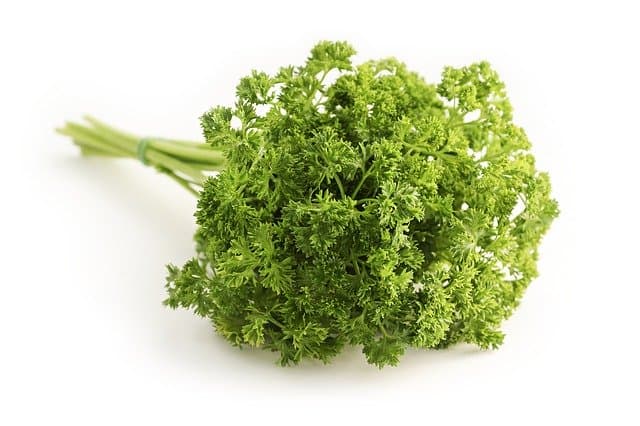
Parsley is a popular herb used in cooking all around the world.
It is rich in Vitamin A, Vitamin B, Vitamin C, Iron, Potassium, and Flavanoids. You can definitely add some parsley into your guinea pig’s diet as well.
However, you must limit the serving as overfeeding can lead to digestive problems as well as the formation of bladder stones in guinea pigs.
Feeding parsley also has lots of benefits for your guinea pigs. Some of the benefits include:
- Prevention of scurvy
- Healthy body growth
- Fights against diseases
- Improves eyesight and other vital functions
However, overfeeding parsley also has some drawbacks. Some common health problems that can arise by overfeeding parsley are:
- Diarrhea
- Stone formation
- Renal system failure
Most of these problems can be avoided if you feed parsley in the right quantity.
Suggested Feeding: Guinea pigs can eat 5-10 sprig of parsley at a time. It can be fed 2-3 times a week. However, make sure you maintain the serving size and feed it with some gap in between two servings to avoid potential health issues.
You can learn more about feeding parsley to your guinea pigs from our in-depth guide on the same.
Collards
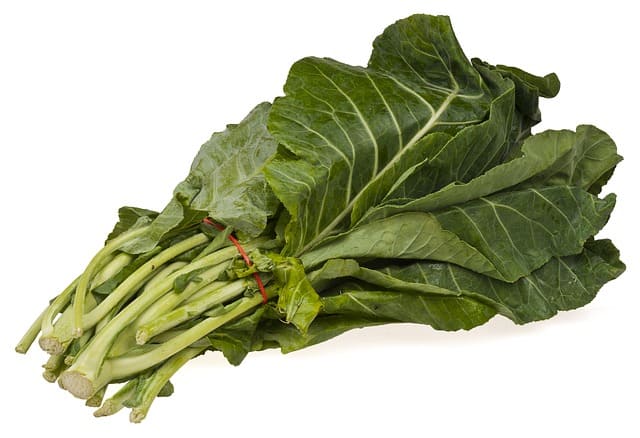
Collard green is another great vegetable for your guinea pigs. It contains lots of Vitamin K, Vitamin A, Vitamin C, Manganese, Fiber, Vitamin B2, Vitamin B-6, iron, and much more.
A study conducted by some organizations in the Southeastern United States ranked Collard Greens as 4th most abundant source of antioxidants.
However, overfeeding collards can have some negative impact on your guinea pig’s health as well. Some of the most common health issues caused by overfeeding collards are:
- Formation of bladder stones
- Diarrhea
- Urinary system problems
Although most of these problems can be avoided by feeding collards sparsely to your guinea pigs.
Suggested Feeding: You can feed one small leaf of collard green to your guinea pigs at a time. Never go beyond 1-2 times feeding every week as it can lead to excess calcium in your guinea pig’s diet, which can further lead to various health issues in them.
Coriander: Best Leafy Greens For Your Guinea Pigs
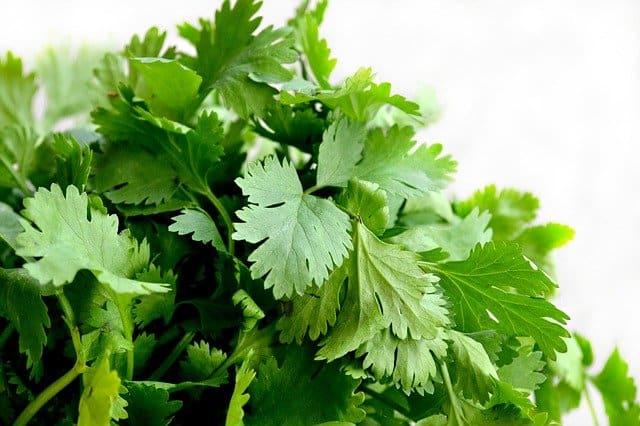
coriander or Cilantro is one of the staple herbs for our guinea pig’s diet.
It is rich in Vitamin C and other vital nutrients, including Manganese, Choline, Beta-Carotene, Beta-cryptoxanthin, Lutein, Zeaxanthin & more.
coriander also possesses a lot of benefits for our guinea pigs. Some of the most prominent benefits include:
- Provides a tonne of Vitamin C thus prevents scurvy
- Strengthen the immune system
- Fights harmful diseases including cancer
- Reduces pain and inflammation
- Also has some Antifungal properties
However, you must ensure you limit the serving size to avoid some potential health issues. Some of the most common health issues of overfeeding are diarrhea and bloating in guinea pigs.
Suggested Feeding: You can feed 5-6 sprig of coriander to your guinea pigs at a time. Cilantro can be fed daily, provided you maintain the right serving size.
Pak choi(Bok Choy) for your guinea pigs
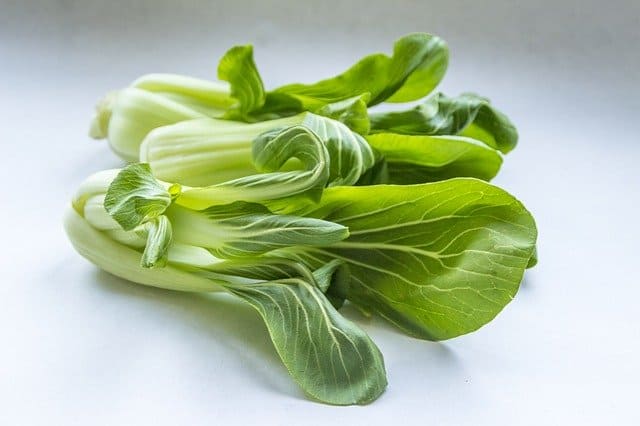
Pak choi or Bok choi is a leafy green of the cabbage family that can be fed to your guinea pigs.
It is rich in Vitamin A, Vitamin K, Vitamin C, Vitamin E, Zinc, Magnesium, etc. which are essential for our guinea pigs.
However, it also contains a decent amount of calcium in it; thus, feeding should be moderated.
Some of the common problems of overfeeding Pak choi to your guinea pigs are: Bloating, Diarrhea, and Stone formation.
However, it has tonnes of benefits also if fed in the right quantity. Some of the significant benefits of feeding pak choi to your guinea pigs are:
- Rich Source Of Vitamin C
- Anti-cancer properties
- Production and growth of collagen that improves bone health
- Reduces chronic inflammation
However, you must ensure to serve it sparsely to ensure your guinea pigs don’t suffer from health issues.
Suggested Feeding: One small leaf of Pak choi can be served to your guinea pig at a time. You can feed pak choi 1-2 times a week at maximum as regular feeding can be harmful to your guinea pig’s health.
Watercress: Best Leafy Greens For Your Guinea Pigs

Watercress is one of the healthiest microgreens you can offer to your guinea pigs.
Packed with a variety of vitamins and minerals, it is a superfood for your guinea pigs. The nutrients in watercress include:
- Vitamin K
- Vitamin C
- Vitamin A
- Vitamin E
- Thiamin
- Riboflavin
- Vitamin B-6
- Magnesium, etc.
Watercress also possesses a lot of benefits for our guinea pigs. Some of the major benefits of watercress include:
- Cancer preventive oxidants
- Full of Vitamin C thus prevents scurvy
- Maintains healthy bones
- Lowers blood sugar level
However, you must still maintain the balance in their diet and mix watercress with other vegetables to create a well-balanced diet.
Feeding too much watercress can lead to health issues like diarrhea, bloating & other gastrointestinal problems in guinea pigs.
Suggested Feeding: You can feed a small bunch(30 grams) of watercress to your guinea pigs in one serving. Although watercress can be fed daily as it is entirely safe for our guinea pigs, it is recommended to serve it 3-4 times a week only.
I would definitely recommend using a salad spinner like this to make sure you dry the extra water from the veggies and get it cleaned adequately before serving.
Sources: Lettuce, Kale, Cabbage, Chards, Spinach, Collards, Parsley, Arugula, Coriander, Pak choi(Bok Choy), Watercress, Diet Composition and Mineral Balance in Guinea Pigs, Dietary Vitamin C, and Vitamin E on Guinea Pig Immune Responses to Mitogens, Vitamin C requirements of the guinea-pig, Is Your Guinea Pig’s Diet Providing the Right Nutrients? Care of Guinea Pigs.
Similar Posts:
- Can Guinea Pigs Eat Cabbage? (Which Variety, Serving, Risks & More)
- Can Guinea Pigs Eat Spinach? (Serving, Risks & More)
- Can Guinea Pigs Eat Collard Greens? (Hazard, Serving Size & More)
- Can Guinea Pigs Eat Beets? (Beetroot leaves, Tops, Roots & More)
- Can Guinea Pigs Eat Swiss Chard? (Hazard, Serving Size & More)
